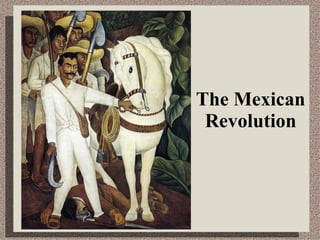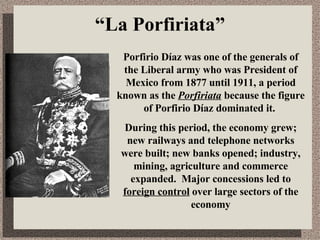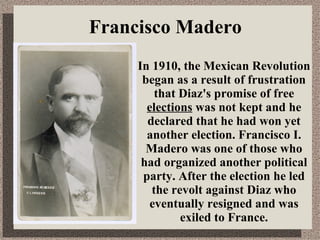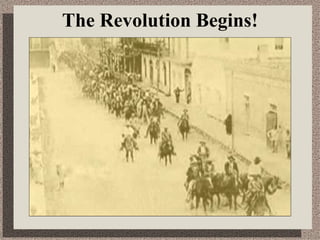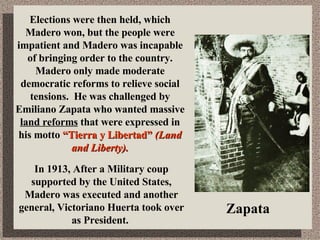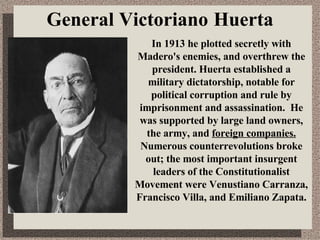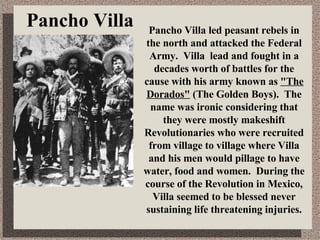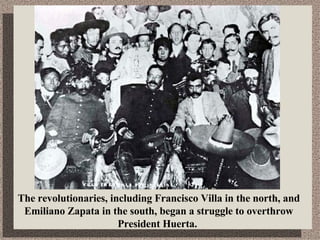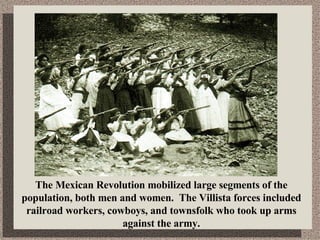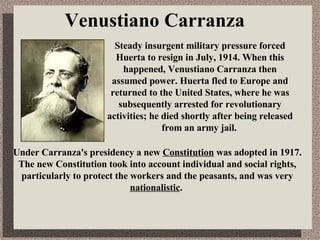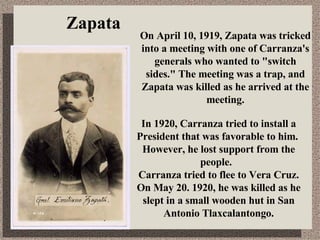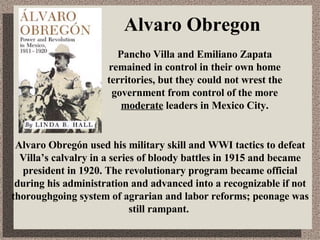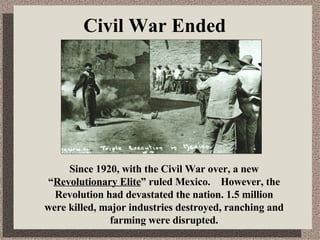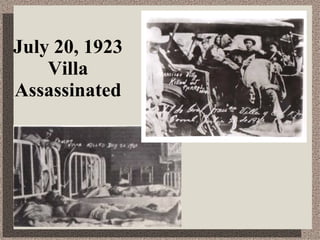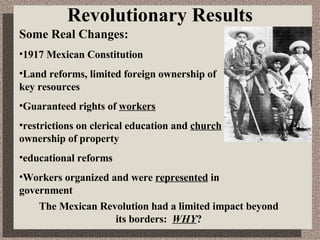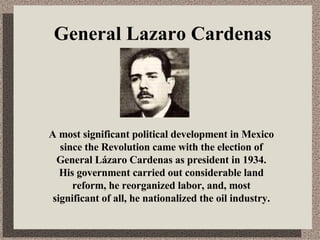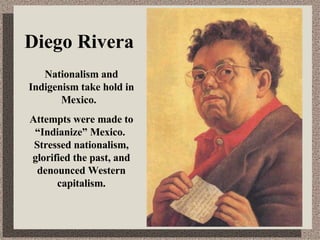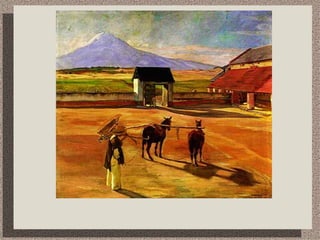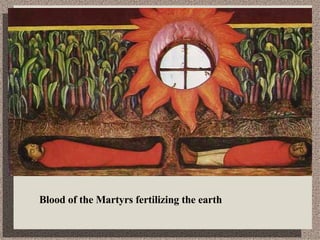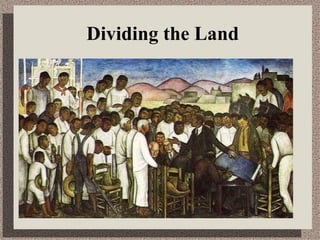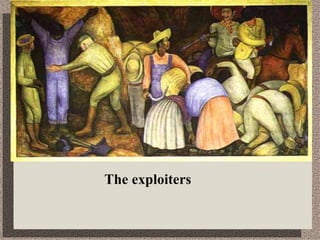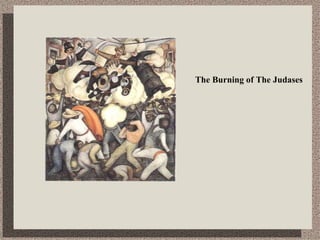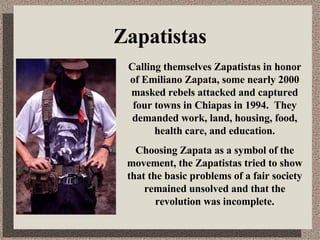Mexrev
- 2. “ La Porfiriata” Porfirio DĂaz was one of the generals of the Liberal army who was President of Mexico from 1877 until 1911, a period known as the Porfiriata because the figure of Porfirio DĂaz dominated it. During this period, the economy grew; new railways and telephone networks were built; new banks opened; industry, mining, agriculture and commerce expanded. Major concessions led to foreign control over large sectors of the economy
- 3. Although President DĂaz brought many benefits to Mexico, he was a dictator - a President who abused his power. Under DĂaz, a few land owners became very wealthy, but the majority of Mexicans remained poor. David Siquieros Mural: "Don Porfirio and his Courtesans". 1957-65
- 4. The Rebellion Begins During the first years of the 20th century, a new generation of educated, young Mexicans that did not belong to DĂaz' group desired change. For the first time in thirty-three years other political parties were formed.
- 5. In 1910, the Mexican Revolution began as a result of frustration that Diaz's promise of free elections was not kept and he declared that he had won yet another election. Francisco I. Madero was one of those who had organized another political party. After the election he led the revolt against Diaz who eventually resigned and was exiled to France. Francisco Madero
- 8. In 1913, After a Military coup supported by the United States, Madero was executed and another general, Victoriano Huerta took over as President. Elections were then held, which Madero won, but the people were impatient and Madero was incapable of bringing order to the country. Madero only made moderate democratic reforms to relieve social tensions. He was challenged by Emiliano Zapata who wanted massive land reforms that were expressed in his motto “Tierra y Libertad” (Land and Liberty). Zapata
- 9. General Victoriano Huerta In 1913 he plotted secretly with Madero's enemies, and overthrew the president. Huerta established a military dictatorship, notable for political corruption and rule by imprisonment and assassination. He was supported by large land owners, the army, and foreign companies. Numerous counterrevolutions broke out; the most important insurgent leaders of the Constitutionalist Movement were Venustiano Carranza, Francisco Villa, and Emiliano Zapata.
- 10. Pancho Villa Pancho Villa led peasant rebels in the north and attacked the Federal Army.Ěý VillaĚý lead and fought in a decades worth of battles for the cause with his army known as "The Dorados" (The Golden Boys).Ěý The name was ironic considering that they were mostly makeshift Revolutionaries who were recruited from village to village where Villa and his men would pillage to have water, food and women.Ěý During the course of the Revolution in Mexico, Villa seemed to be blessed never sustaining life threatening injuries.
- 11. The revolutionaries, including Francisco Villa in the north, and Emiliano Zapata in the south, began a struggle to overthrow President Huerta.
- 12. Soldaderas March
- 13. The Mexican Revolution mobilized large segments of the population, both men and women. The Villista forces included railroad workers, cowboys, and townsfolk who took up arms against the army.
- 14. David Siquieros Mural: "Poeple in Arms" Detail. 1957-65
- 15. Venustiano Carranza Under Carranza's presidency a new Constitution was adopted in 1917. The new Constitution took into account individual and social rights, particularly to protect the workers and the peasants, and was very nationalistic . Steady insurgent military pressure forced Huerta to resign in July, 1914. When this happened, Venustiano Carranza then assumed power. Huerta fled to Europe and returned to the United States, where he was subsequently arrested for revolutionary activities; he died shortly after being released from an army jail.
- 16. Zapata On April 10, 1919, Zapata was tricked into a meeting with one of Carranza's generals who wanted to "switch sides." The meeting was a trap, and Zapata was killed as he arrived at the meeting. In 1920, Carranza tried to install a President that was favorable to him. However, he lost support from the people. Carranza tried to flee to Vera Cruz. On May 20. 1920, he was killed as he slept in a small wooden hut in San Antonio Tlaxcalantongo.
- 17. Alvaro Obregon Alvaro ObregĂłn used his military skill and WWI tactics to defeat Villa’s calvalry in a series of bloody battles in 1915 and became president in 1920. The revolutionary program became official during his administration and advanced into a recognizable if not thoroughgoing system of agrarian and labor reforms; peonage was still rampant.Ěý Pancho Villa and Emiliano Zapata remained in control in their own home territories, but they could not wrest the government from control of the more moderate leaders in Mexico City.
- 18. Civil War Ended Since 1920, with the Civil War over, a new “ Revolutionary Elite ” ruled Mexico. However, the Revolution had devastated the nation. 1.5 million were killed, major industries destroyed, ranching and farming were disrupted.
- 19. Pancho Villa In Jan., 1916, a group of Americans were shot by bandits in Chihuahua, and on Mar. 9, 1916, some of Villa's men raided the U.S. town of Columbus, N.Mex., killing some American citizens . It is not certain that Villa participated in these assaults, but he was universally held responsible. Wilson ordered a punitive expedition under General Pershing to capture Villa dead or alive . The expedition pursued Villa through Chihuahua for 11 months but failed in its objective. Carranza violently resented this invasion and it embittered relations between Mexico and the United States.
- 20. July 20, 1923 Villa Assassinated
- 21. Revolutionary Results Some Real Changes: 1917 Mexican Constitution Land reforms, limited foreign ownership of key resources Guaranteed rights of workers restrictions on clerical education and church ownership of property educational reforms Workers organized and were represented in government The Mexican Revolution had a limited impact beyond its borders: WHY ?
- 22. General Lazaro Cardenas A most significant political development in Mexico since the Revolution came with the election of General Lázaro Cardenas as president in 1934. His government carried out considerable land reform, he reorganized labor, and, most significant of all, he nationalized the oil industry.
- 23. Diego Rivera Nationalism and Indigenism take hold in Mexico. Attempts were made to “Indianize” Mexico. Stressed nationalism, glorified the past, and denounced Western capitalism.
- 24. Ěý
- 25. Flower Vendor
- 26. Blood of the Martyrs fertilizing the earth
- 28. The exploiters
- 29. The Agitator
- 30. The Burning of The Judases
- 31. The Arsenal - Frida Kahlo distributes arms
- 32. Zapatistas Calling themselves Zapatistas in honor of Emiliano Zapata, some nearly 2000 masked rebels attacked and captured four towns in Chiapas in 1994. They demanded work, land, housing, food, health care, and education. Choosing Zapata as a symbol of the movement, the Zapatistas tried to show that the basic problems of a fair society remained unsolved and that the revolution was incomplete.
